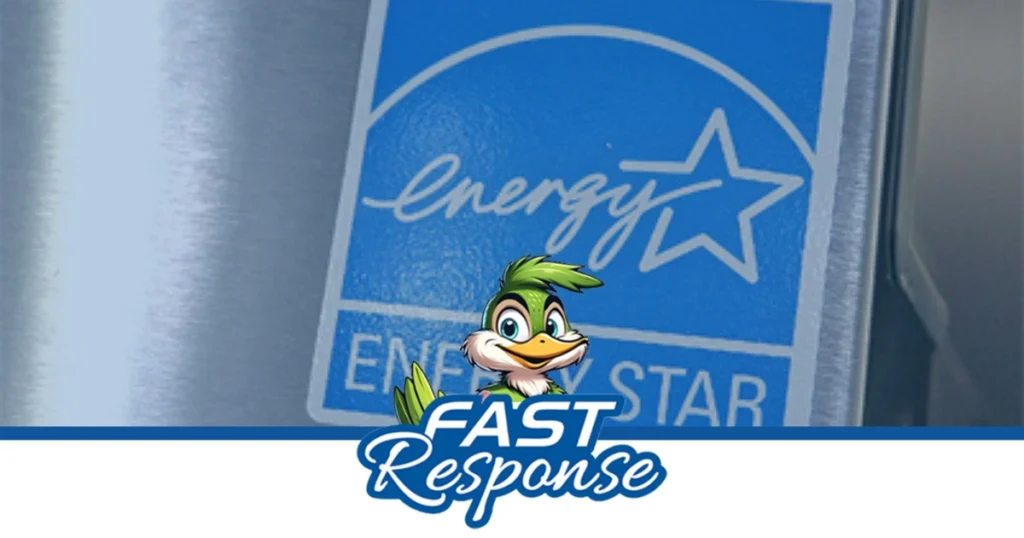- Rated: 5 / 5 based on 125+ reviews. Read our reviews
- Deal Of The Day! $99 Fast Response Membership Claim this offer
Home » HVAC Energy Star Ratings, Explained
HVAC Energy Star Ratings, Explained
Published October 31, 2024

If you’ve ever looked at appliances in the hardware store, you’re probably familiar with the Energy Star sticker. This sticker shows that the appliance is energy-efficient enough to be part of the Energy Star program, which is the US’s standard for efficient appliances.
When you get a new HVAC system, make sure yours has the star of approval to save money and live greener. Fast Response Heating & Cooling explains HVAC Energy Star ratings in this blog post so you can know what to look for!
What Is an Energy Star-Rated Unit?
An Energy Star unit is, essentially, a unit that uses less energy than standard options. They operate the same, but because they’re built with a focus on energy-efficiency, they let you save money and reduce your carbon footprint.
Terms To Know for HVAC Energy Star Ratings
There are several acronyms you should know to determine your HVAC system efficiency. HVAC performance is rated based on these terms, and the requirements for an Energy Star rating are set by the Environmental Protection Agency.
SEER
SEER (Seasonal Energy Efficiency Ratio) is the efficiency measurement for air conditioners and heat pumps. The rating measures a system’s efficiency over the course of an entire season.
The higher the SEER rating, the more efficient your system will be and you’ll save more money. HVAC units must be 14 or higher, though they go as high as 23.
EER
EER (Energy Efficiency Ratio) measures the efficiency of a cooling system. It differs from the SEER because it measures efficiency based off of a single usage rather than the entire season.
AFUE
AFUE (Annual Fuel Utilization Efficiency) is used for furnaces to measure how much fuel is sent out of the chimney instead of turned into heat. Energy-efficient heating is highly obtainable these days since most AFUE ratings are 97-98.5%.
HSPF
HSPF (Heating Seasonal Performance Factor) measures heat pump efficiency over the course of a season, similar to SEER ratings. The current HSPF range is 7.7-13.
Requirements for Energy Star Certification
HVAC Energy Star ratings look at the above factors to determine what score to give a system. The highest possible ratings are often very expensive; however, the lower-rated ones are more affordable while still offering great efficiency.
The minimum requirements are:
- Central air conditioners: Central air conditioners require a SEER rating of 14.
- Room air conditioners: Window or mini split air conditioners should have an EER rating of at least 10.
- Heat pumps: Heat pumps should have a SEER rating of 14 if they also have cooling capabilities. Heat pumps that only produce heat need an HSPF rating of eight.
- Furnaces: Furnaces need an AFUE rating of 85% for oil, and 90% for gas.
Requirements for Energy Star Certification
HVAC Energy Star ratings look at the above factors to determine what score to give a system. The highest possible ratings are often very expensive; however, the lower-rated ones are more affordable while still offering great efficiency.
The minimum requirements are:
- Central air conditioners: Central air conditioners require a SEER rating of 14.
- Room air conditioners: Window or mini split air conditioners should have an EER rating of at least 10.
- Heat pumps: Heat pumps should have a SEER rating of 14 if they also have cooling capabilities. Heat pumps that only produce heat need an HSPF rating of eight.
- Furnaces: Furnaces need an AFUE rating of 85% for oil, and 90% for gas.
Fast Response Heating & Cooling Can Help You Save Energy
If you still aren’t sure which HVAC Energy Star ratings you need to save money and energy over time, Fast Response Heating & Cooling can help. We’ll help you pick the HVAC units that will suit your home the best and give you the best benefits.
Call us today at (945) 292-3188 to schedule a time for us to come out.
Trusted by homeowners
throughout Dallas.




Customer Reviews
What Your Neighbors Are Saying!

"Just wanted to let you know that Ryan came out to my house was very professional explained everything to me and I was very impressed"


"Just wanted to let you know that Ryan came out to my house was very professional explained everything to me and I was very impressed"


"Just wanted to let you know that Ryan came out to my house was very professional explained everything to me and I was very impressed"


"Just wanted to let you know that Ryan came out to my house was very professional explained everything to me and I was very impressed"

Service Area
Serving Dallas And The Surrounding Areas
- Allen
- Balch Springs
- Cedar Hill
- Dallas
- DeSoto
- Duncanville
- Ferris
- Garland
- Allen
- Balch Springs
- Cedar Hill
- Dallas
- DeSoto
- Duncanville
- Ferris
- Garland
- Allen
- Balch Springs
- Cedar Hill
- Dallas
- DeSoto
- Duncanville
- Ferris
- Garland

$99/year
Fast Response Membership
Includes 2 annual tune-ups, priority service, and 10% off all repairs.
